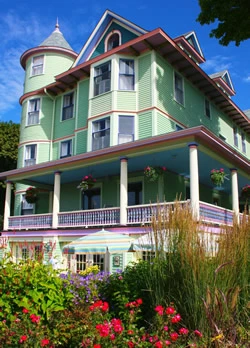Exploring Mackinac Island’s Wetlands: A Hidden Ecosystem
Introduction
Mackinac Island is known for its charming streets and rich history. Visitors come for horse-drawn carriages, fudge shops, and lake views. But beyond the busy town lies something most people miss—wetlands. These quiet areas are full of life and beauty. They offer a different side of the island. It’s like entering a secret universe when you explore them. Calm, green, and rich in nature, they tell a story of their own.
What Are Wetlands and Why They Matter
Areas with year-round or seasonal water cover are known as wetlands. These lands include marshes, swamps, and bogs. They are not just muddy areas. One of the planet’s most significant ecosystems is wetlands. They help clean the water by filtering out dirt and chemicals. They also protect land from flooding.
Here’s why wetlands are so important:
- They support a wide range of plants and animals
- They improve water quality
- They store rainwater and reduce flood risk
- They slow shoreline erosion
On Mackinac Island, wetlands help keep the land balanced. Trees, animals, and even the oxygen we breathe are supported by them.
Wetlands on Mackinac Island: An Overview
The wetlands on Mackinac Island are spread across several areas. Some are near the island’s center. Others are tucked along the shores. Many are hidden behind trees and trails. These wetlands were shaped by glaciers thousands of years ago. As ice melted, water filled low land. This created shallow pools and marshy areas.
The island’s wetlands come in a few forms:
- Marshes: Open areas with water and grasses
- Swamps: Tree-filled wetlands that feel like tiny forests
- Seasonal pools: Wet in spring, dry by summer
Each type plays a role in the island’s health. Some provide homes for birds. Others hold water after heavy rains. Many are peaceful places for visitors to walk or reflect.
These wetlands are more than just landscapes. They are living systems. Quiet, yes—but never still. They are alive with sounds, colors, and stories waiting to be discovered.
Unique Flora and Fauna
Mackinac Island’s wetlands are rich with life. They are quiet homes for plants and animals. Many of these species can’t live anywhere else. Wetlands offer a safe space for them to grow and thrive.
You’ll find plants that love wet soil. Some become tall and wobble in the wind. Others stay low and hug the ground. Common wetland plants on the island include:
- Cattails – tall with brown, fuzzy tops
- Sedges – grass-like plants with sharp edges
- Marsh marigolds – bright yellow flowers in spring
- Wild irises – purple blooms that attract pollinators
- Pitcher plants – uncommon, bug-eating, and found in marshy areas
Animals also call these wetlands home. Insects buzz above the water. Frogs call out in the evening. Birds rest here during long migrations. Some stay all summer to raise their young.
Look for these wetland animals:
- Leopard frogs – green with dark spots, often near the water’s edge
- Red-winged blackbirds – flashy birds perched on reeds
- Dragonflies – fast flyers that hunt mosquitoes
- Painted turtles – sunning on logs in quiet ponds
- Herons and warblers – wading and singing in the trees
These plants and animals make wetlands come alive. They form a system where every part works together.
The Role of Wetlands in Mackinac’s Ecosystem
Wetlands may look calm, but they are always working. They help keep Mackinac Island’s nature in balance. Without them, the island would struggle to stay healthy.
Wetlands clean water as it moves through soil and plants. This helps nearby streams and lakes stay clear. They also act like sponges. They soak up water during heavy rain and slowly release it later. This protects trails, trees, and even roads from flood damage.
Wetlands also link with other island areas. They support:
- Forests by keeping soil moist
- Lakes by filtering runoff water
- Meadows by providing space for pollinators
Birds may nest in the wetland and hunt in the meadow. Frogs may start in the pond and move to the forest. Every part is connected.
These natural systems are fragile. They depend on clean water and careful balance. If one part is harmed, the rest may suffer. That’s why wetlands matter to all life on Mackinac Island.
Visiting the Wetlands: What to Know
Wetlands can be explored, but they need to be respected. Mackinac Island State Park offers several trails that pass near wetlands. Some have boardwalks or signs to guide you.
Tips for a good visit:
- Stay on marked paths to protect plants and animals
- Wear sturdy shoes; some paths may be damp
- Bring binoculars for birdwatching
- Go early for better wildlife views
- Pack out any trash to keep areas clean
A wetland visit is peaceful and slow. Listen to the sounds, watch the plants move, and breathe in fresh air. It’s a quiet adventure that leaves a lasting memory.
Conservation Efforts and Challenges
Mackinac Island’s wetlands are beautiful, but they also face many threats. Changes in climate, rising visitor numbers, and pollution can all cause harm. Wetlands are delicate and must be cared for to survive.
Thankfully, local groups work hard to protect them. Mackinac Island State Park and other conservation teams help manage these wild areas. They monitor plant life, test water, and watch for signs of damage.
Some ongoing efforts include:
- Invasive species removal – getting rid of plants that don’t belong
- Boardwalk construction – guiding visitors to reduce foot traffic damage
- Wildlife tracking – learning how animals use the wetlands
- Water testing – checking for pollution and chemical runoff
But threats remain. Climate change brings more storms and flooding. Rising temperatures can dry out shallow wetlands. When people walk off trails or leave litter behind, they hurt plant life.
Each visitor plays a role in helping or harming. That’s why education and awareness are so important.
Why You Should Explore This Hidden Side of Mackinac
The wetlands offer something different from the rest of the island. They are quiet, still, and full of small wonders. Many guests never see this side of Mackinac. But those who do often say it’s their favorite part.
Here’s why wetlands are worth exploring:
- Peace and quiet – far from the busy town and crowds
- Rich nature – see birds, frogs, and flowers up close
- Learning moments – great for kids, students, and curious minds
- Unique photos – capture rare plants and reflections on still water
A walk through the wetlands is more than a hike. It’s a moment to slow down and connect with nature. You can hear frogs call, see birds dive, and watch light play on the water. It’s a natural world that changes with every season.
You don’t need gear or guides. Just your eyes, ears, and respect for the land.
Conclusion
Mackinac Island’s wetlands are more than just soggy ground. They are living systems filled with color, sound, and purpose. They protect the island, support wildlife, and offer peace to visitors.
Take the time to explore them during your stay. Follow the trails, listen to the breeze, and enjoy a quieter side of Mackinac. When you do, you’re not just visiting—you’re helping protect something truly special.
For a cozy and convenient stay, consider Inn on Mackinac. Located near many walking and biking trails, it’s the perfect base for your nature-filled getaway. Rest well, explore deeply, and leave with memories of Mackinac’s hidden beauty.
Category: Mackinac Island


